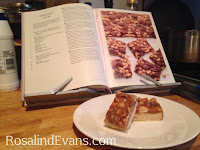
My favorite treat from the village bakery when I was little were the giant, chewy, almond macaroons with rice paper on the bottom, which at that age were about the size of my head! In recent years the macaron (note spelling!) has become a massive baking trend, and I do really like them but I certainly do not have the patience to make them as beautifully as you see them in fancy patisseries. Whilst the basic ingredients are the same for the two, ground almonds, sugar and egg white, the way you blend them is different and for me that's what makes the difference between macaroons and macarons. You could also argue that macaroons are the English version of French macarons, as I have never seen macaroons in any french recipe book that I've read. Although, if you are going to get into baking geography the Italians might want to chip in with the fact that the word macaron is derived from the Italian
macarone or
maccherone which means meringue and is what macaro/ons are both basically made of. For some people, macaroons are in fact made with shredded cocnut and not nuts at all, but seeing as I loathe shredded coconut with a passion, you won't find any of that nonsense on this blog!
 |
| Beautiful Laduree Macarons |
Both confections are made by whipping egg whites with sugar to form a meringue base and then folding the almonds into this very gently to maintain the airiness of the batter so that they do not collapse when baked. I have tried making macarons several times with varying degrees of success. To get the distinctive crisp, smooth shell and a sort of ruffled bottom (that aficionados call its foot), macarons are usually made with very finely ground almonds, or almond flour and icing or confectioners sugar. This results in a much smoother mixture and also creates the distinctive shiny finish. Two of these shells are then sandwiched together with butter cream (mmmm...) To make the classic Laduree macaron the shells have to be the same size which means you have to pipe the mixture out onto the baking sheets and I am just not patient enough for that! Also, it makes so much more washing up and I inevitably get bored half way through the piping, which means I get sloppy, and I end up with different sizes, which then annoys me! So whilst I can appreciate the beauty and deliciousness of the macaron, I will probably be a receiver and eater of them rather than a creator!
Macaroons on the other hand are so much easier to make and far harder to cock up- vital aspects for an easily bored baker like me! This recipe is based on one I found in one of my Mum's ancient Reader's Digest cook books, but tweaked a bit to make the macaroons even more chewy. Its very easy to scale the recipe up or down to however many egg whites you might happen to have. One quantity of the mixture makes approximately 12 about 5cm in diameter. I usually make 3 quantities, as these don't hang around for long!
Ingredients
1 egg white
3 oz caster sugar (90g) If you have it use vanilla sugar.
2 oz ground almonds (60g)
Halved almonds to finish- one for each macaroon
Rice paper
(if you cant get rice paper use bake-o-glide on your baking trays as nothing sticks to it! You could try using baking parchment, but you may find they stick to it. Seriously get some Bake-o-glide you can use it over and over again so it is totally worth it)
- Pre heat oven to 180C
- Line baking trays with rice paper or Bake-o-glide (the number of trays will depend on how much mixture you make)
- Beat the egg whites until they form stiff peaks. If like me you sometimes have trouble telling if your egg whites are at stiff peak stage and panic about over beating them, then check out this
post at the marvelous Joe Pastry website. The pictures and descriptions are great- no more under or over-whipped egg whites! Unlike with macarons it's not the end of the world if you don't get the beating exactly right.
- Once you reach stiff peak stage, continue beating adding the sugar a tablespoon at a time allowing each one to combine fully before adding the next.
- The mixture will become beautifully shiny and thick. This is a basic meringue mix.
 |
| Would love to just stick my head in this bowl! |
- Gently fold the almonds into the meringue mix, trying not t deflate it too much. A metal spoon or rubber spatula is ideal for this. The mixture should be still quite stiff and thick, of you over stir it, it will get more liquid. This isn't the end of the world it just means the finished macaroons will not rise as much and will probably spread more so will be thinner and crispier, but still yummy!
 |
| Fully folded mixture |
- Using a couple of teaspoons, dollop the mixture out onto the rice paper, allowing space around each as they will spread a bit.
- Finish each macaroon with a half almond.
- If you want the macaroons to by extra golden you can brush the tops with egg white, but you don't have to.
 |
| Ready for baking |
-Bake for about 12 minutes, but watch them like a hawk as they go from golden to burnt very quickly! I was not eagle eyed enough and you can see a couple got a little bit crisped!
- Gently pull off the excess rice paper and then let them cool on a wire rack.
 |
| All done |
And that's it really, except to eat and enjoy. They'll keep for a few days in an airtight box, but mine usually disappear within 48 hours...





















































